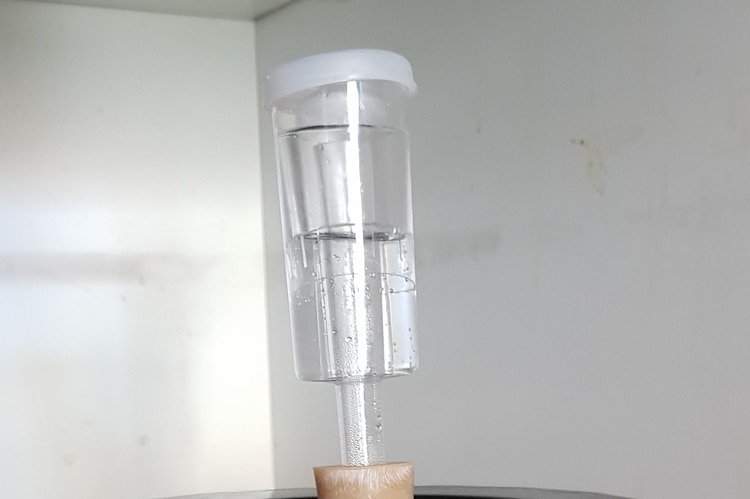Fermenting beer needs protection. Once wort cools it must stay sanitary. Most brewers use airlocks, blow-off tubes, or both. What liquid works best to keep out air and contaminates?
Bottled spring water or filtered water are best and recommended to use as liquid in the airlock. Vodka will certainly keep the lock sanitary too. There is no real trick to it, follow common sense and good process control. Using a straight sanitizer is vehemently not recommended.
When beer hits the fermenter of course it must be capped and sealed from outside air. If using plastic with headspace an airlock is fine.
If using a carboy filled to the shoulders, a blow-off tube is recommended.
Using an airlock
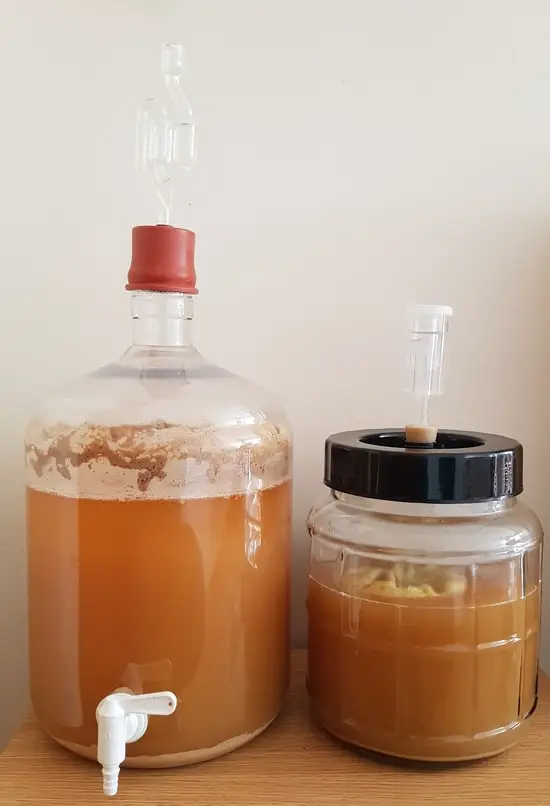
If airlocks were self-care they would be like brushing teeth. Do it right and no thought needs to go into it at all.
As stated, contaminates must be kept out.
There are several types of airlocks and any of them are fine as long as they are airtight.
Cheap is fine, as long as it is airtight. They cost only a few bucks, and doubtless, there are fancy ones too. Choose what suits you.
I always used tap water. Granted, I lived in the mountains and my water came from a well 150 feet down. Was there crud in the water lines, scale, micro-organisms, stuff? Likely, in fact there was granite, literally tiny little gravel in the water. But it always floated to the bottom of the glass. Never had a problem due to airlock contamination.
Best choice for liquid airlock fillers
1. Bottled spring or filtered water
Most homebrewers, extract at least, brew a concentrated wort and de-brew with bottled spring water upon cooling, funnel, and pitch into the fermenter. Save a little water for the airlock. This ensures a sanitary air-seal.
When using gooseneck bubbler airlocks, I often experienced the airlock bubbling in reverse! The beer may be a bit warmer than ambient temperature and as it cools it contracts, creating a vacuum.
A tiny bit of water may splash into the beer; all the more reason to use bottled or filtered sanitary water.
Within 6-12 hours, fermentation will commence, the beer will heat up and the CO2 flow begins.
2. Vodka, or some sort of neutral spirits
Vodka, gin, Everclear, Moonshine (White Likker) as we used to call it (I spent 18 years in Appalachia, we invented the stuff) are all good candidates. This will guarantee a sterile environment, not sanitary but sterile; even better. The difference is that very little may survive in whiskey.
I’ll tell you what spirits are good for sanitizing – your mouth. We used to have a good time on racking and bottling days. We’d take a big shot, swish it around, gargle a bit, and swallow.
You must do this if you use your mouth to pull a siphon. I never filled the hose with water, just not my style.
One time Sam and I were racking and bottling 10 gallons of beer and he had a pint of some aged Bushmills, not the good stuff, but not bad. Aside from the few beers we drank we got a bit toasty “racking beer.”
His amazing wife Susan saw us about 6 that evening and said, “Why are you using that good whiskey to bottle beer?”
“What do you want us to use hon, Pepe Lopez?” he reposted.
3. City tap water
This in some ways is best. It usually has trace to noticeable amounts of chlorine, so in essence it is sanitary. Now, exposed to air, the chlorine will evaporate within 24 hours. However, as long as the airlock was cleaned properly, you have clean water.
I would not worry about any of these dripping into the fermenter. A drop here or there will not hurt, as long as it is clean. Too much chlorine will affect the pH, but not a drop or two.
What not to use in the airlock
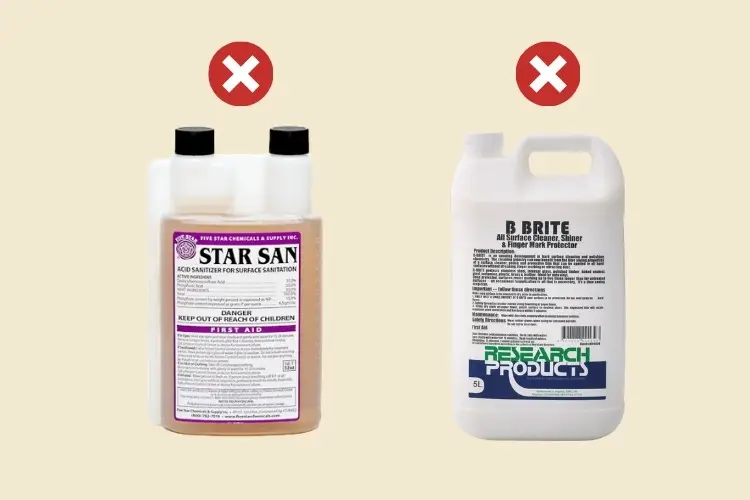
I visit the homebrew forums from time to time checking up on folks, doing some field research. I heard tell of people using Star-San or B-Brite in their airlock. I don’t recommend that.
I understand the logic. A fastidious brewer wants to make sure that NOTHING, no contaminates whatsoever, end up in the beer. I suppose you could, however when you get the back flow (post-pitch, pre-fermentation) some could drip in the wort.
As it is a concentrated media, it could alter the pH of the wort and affect yeast performance. The yeast could be particularly vulnerable while in respiration (the time lag before fermentation when the yeast metabolizes O2 and multiplies).
Be real careful about that. If you must use a sanitary agent, iodophor would be the best thing. Use it in a very light solution (0.25% solution); just the tiniest little drop in a clean glass, and then fill up the airlock.
No products found.
Using Blow-Off Tubes
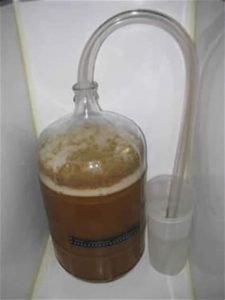
If brewing in carboys, a brewer must certainly use these. I always tried to fill them to the brim to maximize yield. Making sure not to compromise the target gravity, don’t over-dilute the wort.
If using an airlock only, foam, yeast, hops, and protein WILL come out of that bottle. Once the airlock is full, it will blow the cork. Your ceiling, table, carpet, and cave is full of nasty fermentation residue. It will build up pressure and blow; not dangerous but messy.
Usually, the carboy (glass ones) mouth is 1 ¼ inch inside diameter. Go to the brewers supply or a local hardware store and buy about 4 feet of clear vinyl hose, outside diameter 1 ¼ inch.
Cram one end in the bottle and the other in a jug or old pickle jar full of water, thereby making your own airlock. In this case, I would put a little bleach or iodophor in the jar as there is no way the water will travel 3 ft. up the tube and spoil the beer.
After primary fermentation, replace the blow off tube with an airlock.
The case of fermenters with a spigot
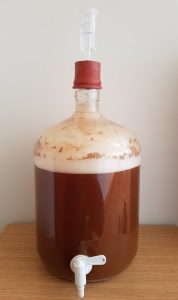
This presents another case where airlocks bubble in reverse. Should a sample be taken from a spigot, it will pull a vacuum in the fermenter and the airlock will pull a little air to compensate.
The airlock liquid will protect the beer and even if a bit of O2 gets in, the beer will have a thick layer of CO2 to insulate and protect it.
In principle, I am not a proponent of spigots on fermenters. Despite their convenience, they present trouble spots for infection. Make sure they are broken down, scrubbed and cleaned with each use.
Cap the spigot when not in use.
The fermentation rests
Whatever the choice of airlock filler, keep it clean. Neutral spirits and sanitary water are fine choices. I used water and that was it.
Homebrewing takes a certain feel and one can only control so much in a house, a non-sanitary environment. Follow process, don’t use obviously dirty equipment or water, and 19 times of 20, the beer will turn out delicious. Airlocks will be the least of your worries.
[email-subscribers-form id=”2″]
Last update on 2025-12-14 / Affiliate links / Images from Amazon Product Advertising API
